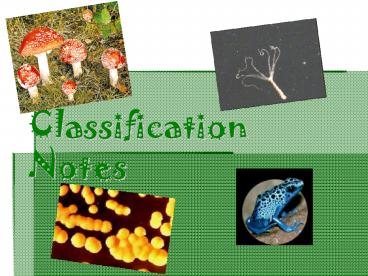Classification Notes - PowerPoint PPT Presentation
Title:
Classification Notes
Description:
Classification Notes Why do we classify? Classification puts organisms into groups by looking at characteristics (traits) they share. Taxonomy Classifying living ... – PowerPoint PPT presentation
Number of Views:185
Avg rating:3.0/5.0
Title: Classification Notes
1
Classification Notes
2
Why do we classify?
- Classification puts organisms into groups by
looking at characteristics (traits) they share.
3
Taxonomy
- Classifying living things into groups based on
their body structures (anatomy), DNA or other
traits.
4
Carolus Linneaus
- Swedish botanist, lived 1707-1778
- Invented binomial nomenclature, the 2-word naming
system we still use today to classify organisms - Called the father of taxonomy.
5
Binomial Nomenclature
- Gives a unique 2-word, Latin, scientific name to
all living things - Genus is capitalized species is not both are
italicized - Examples Homo sapiens human
- Felis domesticus cat
- Panthera tigris tiger
6
TURN TALK
- What are these animals scientific names?
Common name Chimpanzee Paramecium
Domain Eukarya Eukarya
Kingdom Animalia Protista
Phylum Chordata Ciliophora
Class Mammalia Ciliatea
Order Primates Peniculida
Family Hominidae Paramecidae
Genus Pan Paramecium
species troglodytes caudatum
(scientific name) ? ?
7
What would you call this creature?
8
Why are scientific names better than common names?
- Ex pill bug, rolly polly, potato bug
- Common names for the same species are different
and confusing - Binomial Nomenclature uses Latin (a dead
unchanging language) that is understood by
scientists worldwide - Scientific Name Armadillidium vulgare
9
8 taxa of classification
- Domain
- Kingdom
- Phylum
- Class
- Order
- Family
- Genus
- Species
Binomial name or Scientific Name
10
8 taxa of classificationDOMAIN
11
Trick to remember the 8 taxa of classification
- Dumb
- King
- Phillip
- Came
- Over
- For
- Grape
- Soda
12
Species
- Species is the smallest, most specific group in
classification - Organisms in the same species can reproduce
together AND their offspring are fertile.
13
Tool Phylogenya family tree that classifies
organisms by their evolutionary history
14
Tool Cladogram
- Shows older traits (bottom)
- Shows newer or derived traits (top)
15
Tool Dichotomous Key
- Helps identify organisms
- Questions with 2 answer choices lead you through
the key until you find the correct organism
16
END
17
Vocabulary
- These are words you must know when classifying
organisms.
18
prokaryote
- Organism that doesnt have a nucleus
- Its DNA is loose inside the cell
- All bacteria are prokaryotes.
19
Eukaryote
- An organism that has a nuceus with DNA inside.
- All protists, fungi, plants animals are
eukaryotes.
20
Heterotroph
- An organism that has to eat or consume nutrition.
21
Autotroph
- An organism that automatically feeds itself.
- It makes its own food by photosynthesis or
chemosynthesis.
22
unicellular
- An organism with only 1 cell
23
What does multicellular mean?
- Having more than one cell
24
Cell wall
- A hard covering outside the cell membrane.
- Cells of bacteria, fungi and plants have cell
walls.
25
Cell membrane
- A flexible covering outside of all cells!
- All organisms have cell membranes.
- It lets good stuff pass in and keeps bad things
out.
26
motile
- Able to move
- All animals, some bacteria protists are motile.
27
sessile
- Not able to move
- All plants are sessile.
28
Sexual reproduction
- Involves 2 parents
- Some sexual reproduction takes place outside the
parents bodies. They dont touch!
29
Asexual reproduction
- Involves only 1 parent.
- Examples 1 bacterium divides to make 2 bacteria































